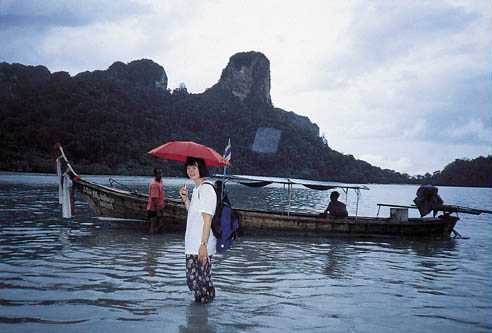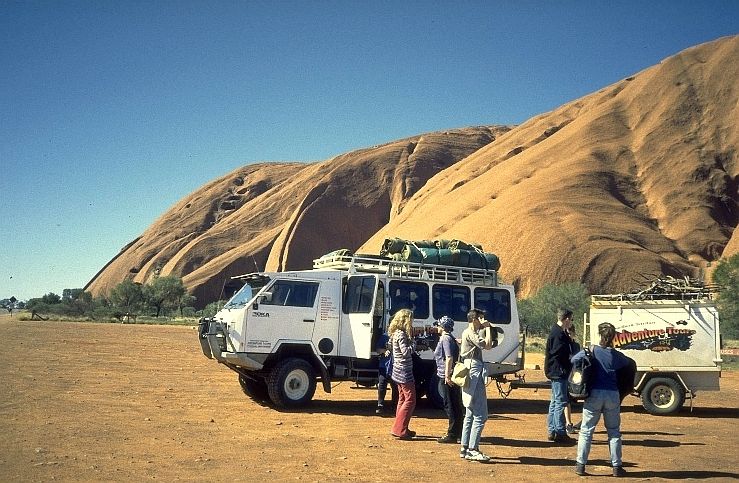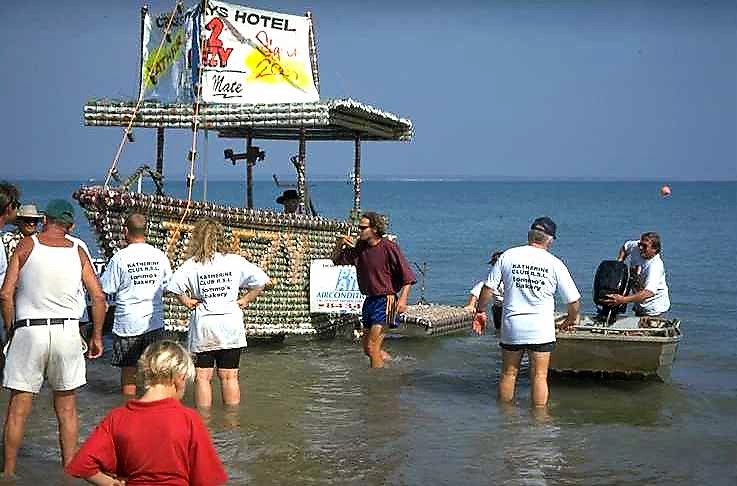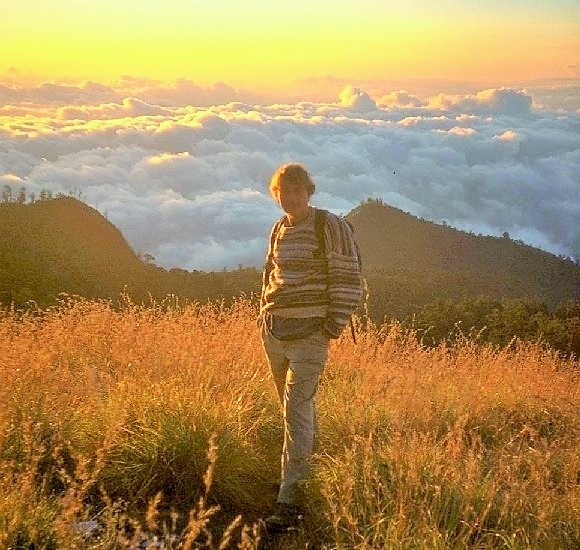At this moment, I am sitting at an altitude of 1.700 meters above sea level in the mountain village Batutumonga in the central highlands of the big island of Sulawesi, Indonesia. Mama Siska’s Home Stay is a house with fragile bamoo-floors, outdoor toilet and without electricity – but all this is fully compensated by her excellent cooking skills – and by the way: The price for one day in her house is about 3 US$ - including 3 meals!
The area around here is excellent for trekking. The countryside is very green, hilly and fertile, with changing rice fields, coffee and bamboo forests, and the air is crystal clear, when the sun is shining. Unlike the coastal areas of Sulawesi, the temperature up here is very pleasant here in Toraja, which the area is called. You will find a culture up here completely different from any other places in Indonesia. Special for the Toraja people is the architecture of their houses and the customs and traditions around their funerals. Their houses carry very big roofs shaped like boats, and all the roofs are facing north/south. According to the legend, the ancestors of the Torajas came from the sea north of Sulawesi, carried their boats to the mountains where the boats finally became part of their houses!
I would like to tell you more about the funerals of the Toraja people, but these ceremonies are too special and complicated to describe in details here. However, they are completely different from the rest of Indonesia, and one of their main features is sacrifice of several pigs or buffalows.

From Hat Rai Leh, Southern Thailand.
I have now been travelling around for about 3 months and seen and experienced incredibly many things. In june, I spent 3 weeks in Thailand with my girl-friend – and during july, I crossed Australia from north to south (from Darwin to Adelaide) visiting a lot of sites – the first one being Kakadu National Park in "The Top End", as the australians call it. The park has a very rich animal life, and especially, it is known for its great number of crocodiles and birds with fantastic colours. One of the factors, which makes Kakadu a very special place, is the difference of the water level in the dry and the wet season. Believe it or not, but when the rainy season starts in october, the water level all over the enormous area increases 4 – 5 meters! No use to say, that this gives the area some very special ecologic conditions!
By the way: My remark about the great number of crocodiles is not only a tourist trap. You will see crocodiles everywhere in the rivers, and sometimes it actually happens, that some foolish tourists ignore the many warning signs and end their lives in the stomach of a crocodile!
Another atttaction in Kakadu is, that the park used to be one of the central places for the aboriginals, who have been living in the country for about 40.000 (forty thousand!) years. You will find several rock and cave paintings as a testimony of an ancient culture doomed to be extinct. Something, which really impressed me, was at a time when we were standing in a rock cave near Nourlangie and our guide told us, that at this place – beyond any doubt - had been living human beings for at least 20.000 years!.

From Ayers Rock, Central Australia.
After visiting Kakadu, I took the Australian Greyhound bus from Darwin to Alice Springs (20 hours) and joined a 5 day, 4 wheel trip in the central desert areas of Australia, sleeping under the stars. One of my highlights in this area was the climb of the famous Ayers Rock – nothing to talk about as a climbing experience, but the view and the light was incredible! The place has a very special atmosphere and is one of the holiest places for the aboriginals. There is a lot of natural caves and holes in the rock, shaped by the water and the wind. In fact, Ayers Rock is made of one gigantic stone, which means, that you will almost not find any gravel or pebbles when you climb it – a strange feeling if you are familiar to climbing mountains. What improves the view is, that the rock is the only hilly formation for miles, and for the same reason, you are able to see it about 100 km before you actually reach the foot of it.
BUT! In general, I was dissapointed at Australia. Well, of course the nature is magnicifent at many places, but the country is far too civilized, westernized and touristic for my taste. Let’s take a look at Kakadu as an example: I had expected a hard accessible area with few or no sealed roads and plenty of aboriginals. Instead, I saw something, which looked like an enormous outdoor museum. There are very few aboriginals in the park, and those who stay there are mainly employed at the booming tourist industry of the park. If you want to se their culture, you have to visit so-called "visitor centers", where you can watch and listen to their rituals and dances – on videos, tapes and posters!
The main part of the aboriginals are living in special "Communities" – i.e. reserves of land closed to foreigners unless you know somebody there or have something special to do in the area. You will also find many aboriginals outside the communities, but almost everybody living in the "white" areas are deeply alcoholized – a very depressing experience.

Those crazy australians! In Darwin, I attended a so-called "beercan-regatta", which is arranged sometimes in town with an enormous audience. It's about constructing the best and fastest vessel made of beercans!
But let me say at least one positive thing about Australia: They make good beer and excellent wines! After Alice Springs, I took the legendary train "The Ghan" from Alice to Adelaide down south – a 20 hour train ride through the middle of nowhere. Down in the winter-cold Adelaide of july, I visited the famous Barossa wine district, which produces a considerable part of the well-known australian wines. I visited several wineries and, of course, I didn’t only take photos and enjoyed the landscape! Regarding the australian beer, I would like to correct a misunderstanding: All foreigners think, that all australians drink the world-famous Forster’s Beer. It’s not true! The majority drink Victoria Bitter!
As a whole, Indonesia is much, much more exciting! You will find a country with a vast number of powerful religions and cultures, and the people are the most friendly and pleasant to foreigners, I have ever met during my travels. Of course, there are no places in the world to day without tourists, but the land is enormous, consisting of thousands of islands, and it’s fairly easy to experience the genuine adventure if you want to. If you are looking for the adventure, please keep away from the southern Bali around Kuta, Senggigi on Lombok and a few other places.
Today, sitting in Batutumonga on Sulawesi at the 11-09-98, I have been travelling around in Indonesia for about 1 ˝ months and have had an immense number of breath-taking experiences. It’s hard to select which of then to describe, but since I am a very enthusiastic trekker, I choose my climb of Mount Rinjani (Gunung Rinjani) on the island of Lombok a couple of weeks ago. THAT turned out to be one of the most amazing landscape experiences I ever had!
I flew from Australia to Bali and continued by buses and boats across Lombok – Sumbawa to Flores in the east. Part of the way back was made onboard a fishing boat from Flores to Lombok together with a group of other rucksack tourists. The trip took 4 days, but we were not in a hurry. On the way, we visited the islands of Rinca and Komodo (famous for the Komodo dragons) and anchored in small idyllic bays where those who liked it jumped into the water and snorkeled. But it was quite OK just to sit on the deck watching the blue mountains of Sumbawa and all the other big and small islands we passed.
In the morning of day 4, the enormous silhouette of Rinjani turned up in the misty morning. Rinjani is an app. 3.700 m. high vulcano, temporary active – last time about 5 years ago. Under the summit, there is a big lake with its water level at an altitude of 2.000 meters – and in the middle of the lake you will find a smaller, temporary active volcanic cone.
The main trail leading to the top starts at the village of Senaru, which is the last accessible site for vehicles. On the way up, you will walk through beatiful mountain forests filled with mystery, mists, lichens and wild monkeys. In fact, there were so many monkeys, that it was sometimes a problem to eat our lunch or dinner in peace!

Standing near my tent above the clouds and the forests at Gunung Rinjani, Lombok.
Click HERE for more photos from Rinjani.
When you reach 2.000 meters above sea level, the forest disappears and reveals an incredible view! From my tent above the forest, I watched the sun go down into a dune of clouds. In the far distance, about 100 km away, I could see the summits of two high vulcanoes on Bali. And after 20 minutes climb upwards from my camp, I reached the crater ridge with the big lake in the bottom.
The next day, I descended to the lake in the crater. This is only possible from one place on the ridge: By a narrow and very steep path clinging to the crater wall, leading 650 meters down. The trip down and back to the ridge takes 4 – 5 hours. Remember, that descending and ascending 650 meters from an altitude of 2.000 meters is quite a trip! But the reward is great. The scenery on the whole trip is unique, and by the way: The water in the lake turned out to be quite warm and very pleasant for swimming in spite of the high altitude, owing to the active vulcano.
It takes 3 or 4 days to climb Rinjani, depending on whether you want to climb the summit at about 3.700 meters or whether your ambitions will be satisfied at the crater ridge. Most of the trekkers hire one or more porters + equipment in the village of Senaru, which is cheap and advisable. But no matter how you plan the climb, you should never go to Rinjani during the rainy season.
If you want to see my main home page with plenty of useful links about travelling and trekking, please click HERE.